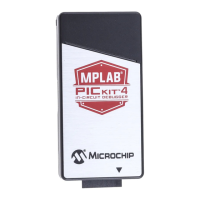External RAM
Off-chip Read/Write memory.
Fatal Error
An error that halts compilation immediately. No further messages will be produced.
File Registers
On-chip data memory, including General Purpose Registers (GPRs) and Special Function Registers (SFRs).
Filter
Determine by selection what data is included/excluded in a trace display or data file.
Fixup
The process of replacing object file symbolic references with absolute addresses after relocation by the linker.
Flash
A type of EEPROM where data is written or erased in blocks instead of bytes.
FNOP
Forced No Operation. A forced NOP cycle is the second cycle of a two-cycle instruction. Since the PIC
microcontroller architecture is pipelined, it prefetches the next instruction in the physical address space while it is
executing the current instruction. However, if the current instruction changes the program counter, this prefetched
instruction is explicitly ignored, causing a forced NOP cycle.
Frame Pointer
A pointer that references the location on the stack that separates the stack-based arguments from the stack-based
local variables. Provides a convenient base from which to access local variables and other values for the current
function.
Free-Standing
An implementation that accepts any strictly conforming program that does not use complex types and in which the
use of the features specified in the library clause (ANSI ‘89 standard clause 7) is confined to the contents of the
standard headers <float.h>, <iso646.h>, <limits.h>, <stdarg.h>, <stdbool.h>, <stddef.h>, and
<stdint.h>.
GPR
General Purpose Register. The portion of device data memory (RAM) available for general use.
Halt
A stop of program execution. Executing Halt is the same as stopping at a breakpoint.
Heap
An area of memory used for dynamic memory allocation where blocks of memory are allocated and freed in an
arbitrary order determined at run-time.
Hex Code/Hex File
Hex code is executable instructions stored in a hexadecimal format code. Hex code is contained in a hex file.
Hexadecimal
The base 16 numbering system that uses the digits 0-9 plus the letters A-F (or a-f). The digits A-F represent
hexadecimal digits with values of (decimal) 10 to 15. The rightmost digit counts ones, the next counts multiples of 16,
then 16
2
= 256, etc.
Glossary
© 2020 Microchip Technology Inc.
User Guide
DS50002751D-page 70

